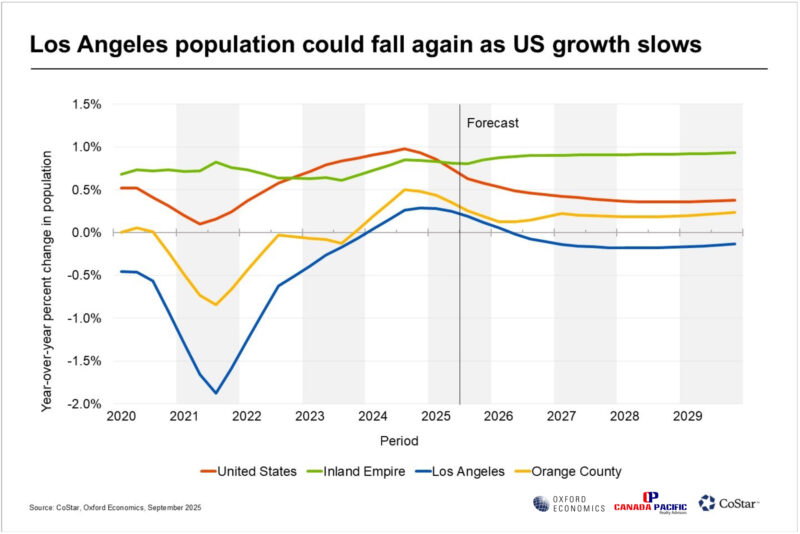Demand for industrial space in coastal Southern California has declined. Los Angeles County has suffered the most severe contraction in tenant occupancy of any industrial market across the country, both by raw square footage and by percentage of inventory.
Current Southern California vacancy rates:
- Los Angeles County (6.2%) – Highest since 2000
- Orange County (5.7%) – Highest since 2012
- Inland Empire (7.8%) – Highest since 2011
Since the beginning of 2020, over 10 million square feet of logistics building space has been vacated on net in the Los Angeles industrial market, amounting to a 1.7% contraction. In addition, 13 million square feet of specialized buildings (predominantly manufacturing) and 2 million square feet of flex building space have been vacated. In Orange County’s industrial market, logistics building users have shed over 1 million square feet, or 0.7% of occupancy.
Impacts of the pandemic weigh on Los Angeles and Orange County
Those post-pandemic contractions in logistics occupancy rank worst among the largest 40 U.S. markets. Besides New York’s Long Island, all other markets have seen a proliferation of industrial users and logistics occupancy in the post-pandemic era, as growing retail sales have driven stronger demand for buildings to hold and transfer goods.
Most other markets have also seen population growth over the past five and a half years. As populations and households swell, more shoppers necessitate a stronger flow of goods, prompting more logistics players and retailers to open warehouses or establish regional hubs. Service-related businesses also rise to accommodate growing capacity.
Significant expansion in high-population growth markets
The metropolitan areas that have achieved above-average population growth in the post-pandemic era have also seen a highly correlated rise in demand for logistics space. Among the 40 most populous U.S. markets, logistics occupancy has soared off the charts: by nearly 50% in Austin, Texas, alongside population growth since the beginning of 2020 of 15%; by 39% in Phoenix, where population is up 9%; and by 33% in Las Vegas, along with 8% higher population. Logistics occupancy has expanded by at least 16% in each of the five markets where post-pandemic population growth exceeds 10%.
Los Angeles and Orange County’s population loss coincides with a loss of occupiers and rising logistics building vacancies. Cleveland, New York, California’s East Bay and Pittsburgh have also lost population and experienced a weaker logistics expansion of under 5%.
Contrasting trends in Los Angeles, Orange County and the Inland Empire
West Coast port markets are experiencing the impact of declining logistics demand. But, while vacancy also shot higher in the adjacent Inland Empire industrial market, its post-pandemic period vacancy expansion is attributable to supply growth rather than occupancy loss. In contrast to LA and OC, logistics occupancy in the Inland Empire has expanded in the post-pandemic era by an impressive 16%, boosted by a substantial 4% population growth.
Within Southern California, both population and logistics demand growth have been concentrated in the Inland Empire, which boasts available land, more affordable housing and an industrial labor supply. Land is also much more available in Texas markets, Phoenix and Las Vegas, where occupancy has soared.
Outlook and market recovery potential
Los Angeles and Orange County managed to reverse the tide and gain population in 2024. Population growth in the Inland Empire also increased in 2024.

But immigration into the country has slowed this year, curtailing population growth, and Oxford Economics is forecasting population loss again for Los Angeles County from 2026 through the five-year forecast, which could impair a rebound in demand for logistics. Orange County should remain above water but is forecast to grow its population slowly, by around 0.2% annually. Meanwhile, population growth in the Inland Empire is forecast to accelerate to over 0.9% annually.
Sources: CoStar Analytics, Oxford Economics, U.S. Census Bureau






